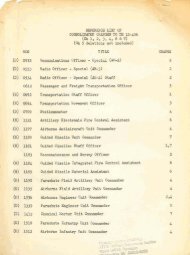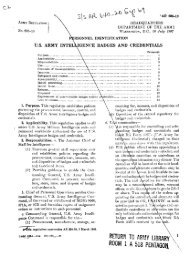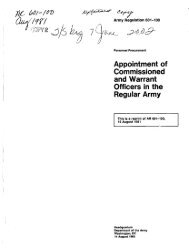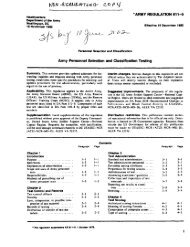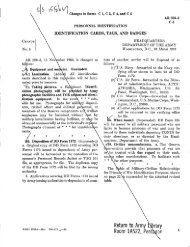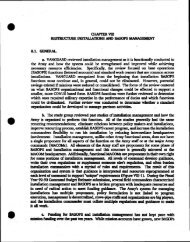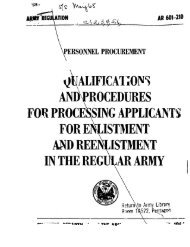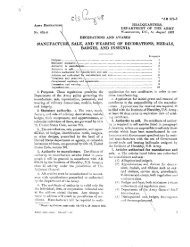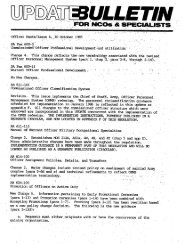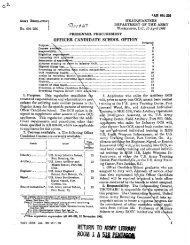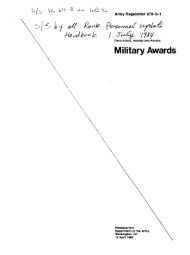May 1971 - Washington Headquarters Services
May 1971 - Washington Headquarters Services
May 1971 - Washington Headquarters Services
You also want an ePaper? Increase the reach of your titles
YUMPU automatically turns print PDFs into web optimized ePapers that Google loves.
AR 672-10<br />
(1) Individuals and unit purification of<br />
water in canteens, 5-gallon cans, and lyster<br />
bags.<br />
(2) Testing potability of water.<br />
(3) Mess sanitation, including inspection<br />
of food handlers and cleaning of mess gear in<br />
the field.<br />
(4) Waste disposal in the field, to include<br />
kitchen waste, and human liquid and solid<br />
wastes.<br />
(5) Prevention of insect-borne diseases.<br />
(6) Personal hygiene in the field.<br />
d. Bandaging and splinting. A written examination<br />
of 15 questions (true-false or multiple<br />
choice) on the general subject of bandaging<br />
and splinting will be given to all individuals.<br />
These questions will be based on FM 21-11. In<br />
addition, a practical exercise will be conducted<br />
requiring each individual to apply two standard<br />
and two improvised splints and four different<br />
types of bandages.<br />
e. Transportation of the sick and wounded.<br />
A written examination of 15 questions (truefalse<br />
or multiple choice) on the general subject<br />
of transportation of the sick and wounded will<br />
be given to all individuals being tested. These<br />
questions will be based on FM 8-35. In addition,<br />
a practical exercise will be conducted to demonstrate<br />
unusual carry methods; placing patients<br />
on litters, including proper loading into ambulances<br />
and aircraft (both fixed wing and<br />
rotary wing); and simulated extrication and<br />
treatment of a wounded soldier trapped in a<br />
tank or other vehicle. Practical exercise will be<br />
modified as required for female AMEDS personnel<br />
being tested.<br />
/. Emergency medical treatment procedures.<br />
A written examination of 15 questions (truefalse<br />
or multiple choice) on the general subject<br />
of emergency medical treatment procedures will<br />
be given all individuals being tested. These<br />
questions will be based on TM 8-230 and FM<br />
21-11. In addition, a practical exercise will be<br />
conducted requiring each individual to demonstrate<br />
his ability to—<br />
(1) Control bleeding.<br />
(2) Control shock.<br />
(3) Properly resuscitate a person, using<br />
DA approved methods.<br />
(4) Perform external cardiac massage.<br />
(5) Perform proper methods of applying<br />
both improvised and standard dressings.<br />
(6) Maintain a sterile field.<br />
(7) Perform proper venipunctures.<br />
(8) Prepare patient and blood or other<br />
material for intravenous infusion.<br />
(9) Treatment of injury due to hot or cold<br />
environment in frontline units and in field<br />
medical units.<br />
g. Medical records. A written examination of<br />
10 questions (true-false or multiple choice) on<br />
the general subject of medical records will be<br />
given to all individuals being tested. These<br />
questions will be based on TM 8-230, AR 40-<br />
400, and AR 40-403. In addition, a practical<br />
exercise will be conducted requiring each individual<br />
to prepare several DD Forms 1380 (U.S.<br />
Field Medical Card) and any other medical record<br />
or reports considered appropriate.<br />
h. Map reading and use of compass. Individuals<br />
will be tested in the following:<br />
(1) Grid coordinates.<br />
(2) Orienting a map to the ground.<br />
(3) Common topographic symbols.<br />
(4) Common military symbols.<br />
(5) Determination of terrain elevations.<br />
(6) Determination of map distances.<br />
(7) Compass course, both day and night.<br />
See paragraph 11, AR 600-73, for recommended<br />
specific courses.<br />
i. Basic signal communications. Individuals<br />
will be tested in the following:<br />
(1) Field message writing.<br />
(2) Phonetic alphabet.<br />
(3) Transmitting and receiving a voice<br />
radio transmission to include proper security.<br />
(4) Operation of a field telephone. See FM<br />
24-18 and FM 24-20.<br />
j. CBR. Individuals will be tested in the following<br />
:<br />
(1) Methods of alarm to warn of impending<br />
chemical, biological, or nuclear attack.<br />
(2) Assisting patients in putting on protective<br />
mask.<br />
AGO 8501A



